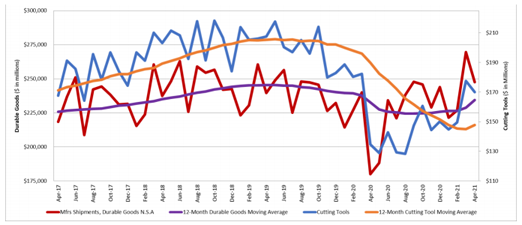April cutting tool orders up 26.3 percent
April 2021 U.S. cutting tool consumption totaled $170 million, up 26.3 percent compared with $134.6 million reported for April 2020.
 |
| The graph above includes the 12-month moving average for the durable goods shipments and cutting tool orders. These values are calculated by taking the average of the most recent 12 months and plotting them over time. |
This total, as reported by companies participating in the Cutting Tool Market Report collaboration, was down 4.3 precent from March's $177.6 million, according to the U.S. Cutting Tool Institute (USCTI) and AMT – The Association For Manufacturing Technology.
With a year-to-date total of $641.9 million, 2021 is down 6.4% when compared to April 2020.
“While cutting tool industry sales contracted slightly from March to April, the general trend of recovery appears to be holding in spite of supply chain disruptions, the lack of incentive for the workforce to return, and other challenges our manufacturing customers are navigating,” said Bret Tayne, president of USCTI.
Costikyan Jarvis, president of Jarvis Cutting Tools, commented, “The April results show significant year-over-year increases, but that is benefiting from being compared to the first of the lockdown months. Unfortunately, the month-over-month results are not as strong. The April results suffered a 4.3% drop from March 2021 and indicate a pause in manufacturing’s return to pre-COVID levels.
“The macro trends are still strong. April’s PMI of 60.7 showed continued expansion, and the University of Michigan’s consumer confidence number of 88.3 remains high. All these point to a strong second half of 2021 and continued strength in 2022. Despite these positive trends, manufacturing is still facing immediate challenges. Commercial aerospace is still weak with no improvement on the near horizon. The chip shortage for automobiles is affecting demand, and finally, there are inflationary pressures being felt. The hiring of staff continues to be a challenge, and section 232 tariffs are still in place.”











